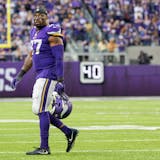It is very Vikings-esque to have a confusing quarterback situation, just as it is very much like the Vikings to have a surprising player perform well enough at the position to fuel championship talk.
That happened in 1998, when veteran Randall Cunningham did it. It happened in 2009, when Brett Favre arrived late in training camp. Both of those Vikings teams — not like you need a reminder — came oh-so-close to reaching the Super Bowl.
I'm not here to say Case Keenum is playing at the level of either of those two QBs, each of whom was at least in the MVP conversation in those seasons. But there is this: If we look at objective measures designed to get to the heart of what a quarterback is contributing to a team, Keenum is playing at a higher level in 2017 than any Vikings quarterback since Favre in 2009.
Yes, Keenum has been better than Sam Bradford was in 2016. Yes, he's been better than Teddy Bridgewater was in 2015 or 2014. He's certainly delivered better than any QB play the Vikings received from 2010-13.
Before you dismiss this as nothing but a ridiculous hot take, let me explain:
There are no perfect metrics when evaluating the play of a quarterback in a vacuum, but three that aim to do a pretty good job are Total QBR (developed by ESPN) as well as Defense-adjusted yards above replacement (DYAR) and Defense-adjusted value over average (DVOA), both used by Football Outsiders.
Total QBR, developed in 2011, aims to "incorporates all of a quarterback's contributions to winning, including how he impacts the game on passes, rushes, turnovers and penalties" while also seeking to contextualize success or failure depending on game situations.
DYAR and DVOA attempt to do similar things, albeit with different formulas. DYAR is focused on total value, while DVOA is focused on value per play, but both are trying to add context beyond mere counting stats like yards and touchdowns (since a touchdown pass, say, when a team is down 38-10 doesn't have the same meaning as one when a game is 17-17).


